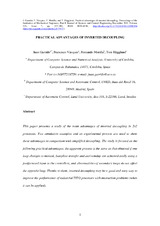Mostrar el registro sencillo del ítem
Practical advantages of inverted decoupling
| dc.contributor.author | Vázquez Serrano, Francisco J. | |
| dc.contributor.author | Morilla, Fernando | |
| dc.contributor.author | Hägglund, T. | |
| dc.contributor.author | Garrido, J. | |
| dc.date.accessioned | 2016-04-11T08:36:41Z | |
| dc.date.available | 2016-04-11T08:36:41Z | |
| dc.date.issued | 2011 | |
| dc.identifier.issn | 0959-6518 | |
| dc.identifier.uri | http://hdl.handle.net/10396/13401 | |
| dc.description.abstract | This paper presents a study of the main advantages of inverted decoupling in 2x2 processes. Two simulation examples and an experimental process are used to show these advantages in comparison with simplified decoupling. The study is focused on the following practical advantages: the apparent process is the same as that obtained if one loop changes to manual, bumpless transfer and anti-windup are achieved easily using a feedforward input in the controllers, and abnormalities of secondary loops do not affect the opposite loop. Thanks to them, inverted decoupling may be a good and easy way to improve the performance of industrial TITO processes with interaction problems (when it can be applied). | es_ES |
| dc.format.mimetype | application/pdf | es_ES |
| dc.language.iso | eng | es_ES |
| dc.rights | https://creativecommons.org/licenses/by-nc-nd/4.0/ | es_ES |
| dc.source | Practical advantages of inverted decoupling, Proceedings of the Institution of Mechanical Engineers, Part I: Journal of Systems and Control Engineering, 225(7), 977-992 (2011) | es_ES |
| dc.subject | Decoupling control | es_ES |
| dc.subject | Inverted decoupling | es_ES |
| dc.subject | Simplified decoupling | es_ES |
| dc.subject | PID controller | es_ES |
| dc.subject | Bumpless transfer | es_ES |
| dc.subject | Anti-windup | es_ES |
| dc.subject | TITO processes | es_ES |
| dc.title | Practical advantages of inverted decoupling | es_ES |
| dc.type | info:eu-repo/semantics/article | es_ES |
| dc.relation.publisherversion | http://pii.sagepub.com/content/225/7/977 | es_ES |
| dc.rights.accessRights | info:eu-repo/semantics/openAccess | es_ES |

